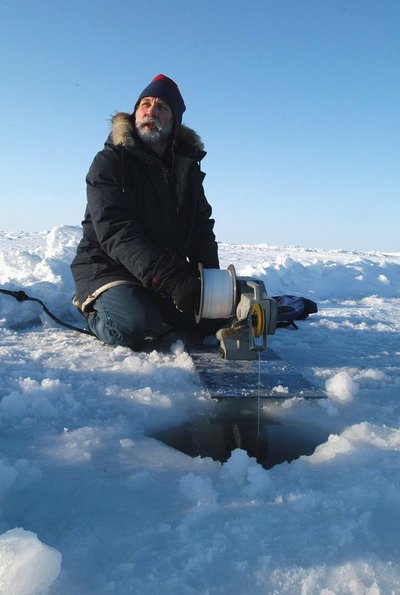May 15, 2003
Just back from expedition: Scientists taking pulse of Arctic Ocean
Retrieving the second year-round mooring ever used at the North Pole was among the challenges faced April 21 to May 9 during North Pole Environmental Observatory work led by James Morison, an oceanographer with the University of Washington’s Applied Physics Laboratory.
In addition to recovering the mooring, 15 polar scientists and engineers installed a new mooring, deployed a fleet of sophisticated drifting buoys on the ice and conducted surveys of water conditions across hundreds of miles. The work is part of a $3.9 million project funded by the National Science Foundation to take the year-round pulse of the Arctic Ocean and learn how the world’s northernmost sea helps regulate global climate.
Since the 1980s scientists have seen arctic waters warm and the ice pack thin. The magnitude and rapid speed at which these changes occurred surprised many scientists and heightened concern that more radical changes are possible. Computer modelers say the trends fit how the Arctic could respond to warming caused by the buildup of greenhouse gases. Still, the changes might simply be part of a natural cycle.
Scientists from six schools, agencies
The North Pole Environmental Observatory program involves researchers and engineers from the University of Washington, NOAA’s Pacific Marine Environmental Laboratory in Seattle, Army’s Cold Regions Research and Engineering Laboratory in Hanover, N.H., the Japanese Marine Science and Technology Center in Yokosuka City, Oregon State University and the Naval Postgraduate School in Monterey, Calif.
Mooring
The mooring is a 2.7-mile-long cable anchored to the seafloor and strung with instruments that monitor ocean conditions and ice for a full year.
It’s the third such mooring to be put in place. Data from the moorings used each of the previous two years are giving scientists year-round information about layers of water that are among the key determinants of how thick – or thin – the ice is in the Arctic.
Drifting buoys include two Web cams this year
Nine buoys were installed and will ride at least a year with the ice as it circles the pole and heads toward the Atlantic. Scientists receive data via satellite. On some the instruments are strung below into the ocean, on others there are monitors above the ice tracking weather and sunlight, some have both, and one measures heat as it moves between the ocean, ice and atmosphere.
The ice pack has proved unhealthy for many a drifting buoy, happily sending data one day and then never being heard from again after being crushed by shifting ice or chewed by polar bears. Thus researchers with NOAA’s Pacific Marine Environmental Laboratory have aimed two Web cams at a couple key buoys this year in order to try to determine what is happening if they should stop working. The Web cams also provide information about the snow cover and weather.
Visit the North Pole via the Web at http://www.arctic.noaa.gov/gallery_np.html.
Surveying to gain insights into broad changes in the circulation of the ocean.
As another part of the North Pole Environmental Observatory program, scientists used a helicopter and plane to hopscotch across the ice, stopping to lower instruments into the ocean. Water from the Pacific and Atlantic oceans make their way into the Arctic and both can affect ice thickness. Scientists are interested in the meandering border where these waters meet and begin mixing because Pacific waters carry nutrients and relatively fresh water across the Arctic Ocean into the North Atlantic Ocean.
New this year was particularly intense sampling of the ocean north of Canada’s Ellesmere Island. It is emerging as such a good area to monitor changes in Pacific and Atlantic waters that one scientist nicknamed it the freshwater switchyard of the Arctic.
###
For more information:
— Sandra Hines, public information officer, 206-543-2580, shines@u.washington.edu
— More details about work plan this year: http://psc.apl.washington.edu/northpole/Plans2003.html
— Daily reports from this year’s camps: http://psc.apl.washington.edu/northpole/2003Reports.html
******
Images for use by news media only:
http://www.washington.edu/newsroom/news/images/northpole/morisonCTD.jpg
University of Washington oceanographer Jamie Morison, leader of the North Pole Environmental Observatory program, lowers instruments on a line to survey temperatures and salinity in the Arctic Ocean. Photo credit: National Science Foundation/Peter West
http://www.washington.edu/newsroom/news/images/northpole/fluxbuoy.jpg
Tim Stanton of the Navel Postgraduate School of Monterey, Calif., works on one of the buoys deployed by U.S. scientists as part of this North Pole Environmental Observatory project. Photo credit: University of Washington/Dean Stewart
http://www.washington.edu/newsroom/news/images/northpole/mooring.jpg
University of Washington field engineer James Johnson prepares to lower another instrument on the cable of this year’s mooring at the North Pole. Photo credit: University of Washington/Mike Ohmart
http://www.washington.edu/newsroom/news/images/northpole/CTDcast.jpg
University of Washington oceanographer Michael Steele takes advantage of a lead, a large crack in the ice, to lower instruments into the Arctic Ocean. Photo credit: University of Washington/Roger Anderson
###



